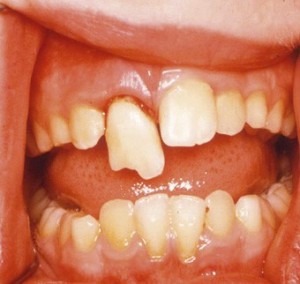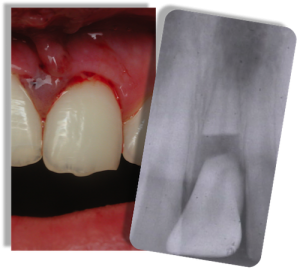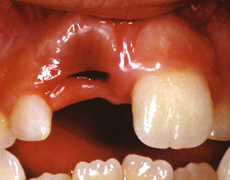The management of tooth fracture in children is distressing for both child and parent and often difficult for the dentist. However, trauma is one of the most common presentations of young children to a pediatric dentist. Trauma not only compromises a previously healthy dentition but may also leave a deficit that affects the self-esteem and quality of the life and commits the person to life-long dental maintenance.
What causes traumatic injuries to a child’s teeth?
Most injuries are caused by falls and play accidents. Tooth displacement (luxation) injuries to upper front teeth predominate in toddlers because of their frequent falls during play and attempts at walking. Injuries are generally more common in boys. Blunt trauma tends to cause greater damage to the soft tissues and supporting structures whereas high-velocity or sharp injuries cause luxations and fractures of the teeth.
What are the predisposing factors that most likely cause traumatic injuries?
-
Class II division I malocclusion, whereby the upper teeth are more protruded.
-
Protruded front teeth measuring more than 6mm have threefold increase in the risk.
Why is history taking done when the child is presented to the dentist?
As dental injuries may become the subject of litigation or insurance claims, a thorough history and examination is mandatory. Where possible, injuries should be photographed. An accurate history gives important information regarding:
-
Status of the dentition at presentations
-
Prognosis of injuries
-
Other injuries sustained
-
Medical complications – congenital heart disease, bleeding disorders, allergies, immunosuppresion
-
Possible litigation
Questions most likely asked by the dentist:
-
Where did the injury take place?
-
How did it happen?
-
When did it happen?
-
Were there any other injuries?
-
What initial treatment was given?
-
Have there been any other dental injuries in the past?
-
Are current immunization up to date?
What examination procedures are performed for traumatic dental injuries?
Trauma examination and records
-
Extra oral wounds and palpation of the facial skeleton
-
Injuries to oral mucosa or gums
-
Palpation of jaw bone
-
Displacement of teeth
-
Abnormalities in occlusion
-
Extent of tooth fractures, pulp exposure, color changes
-
Mobility of teeth
-
Reaction to pulp sensibility tests and percussion
Head injury
Closed head injury is the most common cause of childhood death in accidents. If there is any suggestion that a traumatic head injury has been sustained, the child should be immediately medically assessed, preferably in a pediatric casualty department.
Signs of closed head injuries
-
Altered or loss of consciousness
-
Bleeding from the head or ears
-
Disorientation
-
Prolonged headache
-
Nausea, vomiting, amnesia
-
Altered vision or unilateral dilated pupil
-
Seizures or convulsions
-
Speech difficulties
What investigations are performed for traumatic dental injuries?
The request for x-rays is obviously made after a thorough investigation. There is great value in using extra oral films in young children. In the very upset or difficult child, it may be the only way that some clinical information can be gained in the acute phase of management.
Pulp assessment tests provide an essential baseline measure of tooth pulpal status. It is common that the initial responses at presentation may be inaccurate; however it is important that results are recorded for later comparisons.
Fasting requirements
If the child requires extensive work under general anesthesia, it is important to check fasting details. A child over 6 years of age must be fasted at least 6 hours without solids or liquids. Children under the age of 6 years must be fasted for 6 hours without solids and 2 hours without liquids.
Immunizations
If a child has sustained injury that involves contamination of the wound with soil, especially from a farm area, their tetanus immunization status must be determined. If the child has completed their normal immunization schedule, under normal circumstances boosters are not required.
What treatment procedures are performed for traumatic dental injuries?
Teeth fractures can be fixed with composite resin and may require root canal treatment later on if the fracture line is near or at the pulp. Loose teeth may be splinted and a soft diet is advised.
If a permanent front tooth is avulsed or completely displaced from the tooth socket, the chance of successful retention is enhanced by minimizing the extra oral time (time outside the mouth). Even if the tooth has been out of the mouth for an extended period, it is usually still better to replant the tooth, with the knowledge that success might be unlikely. In the mixed dentition, this is important, as replantation of even questionable teeth will allow normal establishment of the arch and occlusion. Furthermore, orthodontic treatment planning is simpler if the tooth remains in the socket. These teeth are usually lost by replacement resorption.
To be continued in Part 2



